7 Low-Maintenance Landscaping Ideas for Mississippi
BY ANDIE IOO | JUNE 6TH, 2023 | MISSISSIPPICan you imagine your Mississippi community without towering shade trees, colorful wildflowers, or big blooming azaleas in the spring? Not a pretty picture, is it? Landscaping is the decorative frosting on your community’s cake. Luckily, landscaping doesn’t have to require backbreaking labor. We’ve rounded up 7 low-maintenance landscaping ideas for Mississippi landscapes.
Low-maintenance landscaping means less time spent mowing, fertilizing, weeding, overseeding, and spraying for pests and diseases. Not only will you work less, but you’ll also be helping the environment and protecting future generations.
In this article, we will cover:
7 Low-Maintenance Landscaping Ideas for Mississippi
- Landscape With Native Plants
- Add Hardscapes
- Conserve Water With Xeriscaping
- Plant Groundcover
- Install Artificial Turf
- Mulch Your Flower Beds
- Plant Perennials
FAQ About Low-Maintenance Mississippi Landscaping
7 Low-Maintenance Landscaping Ideas for Mississippi
1. Landscape With Native Plants
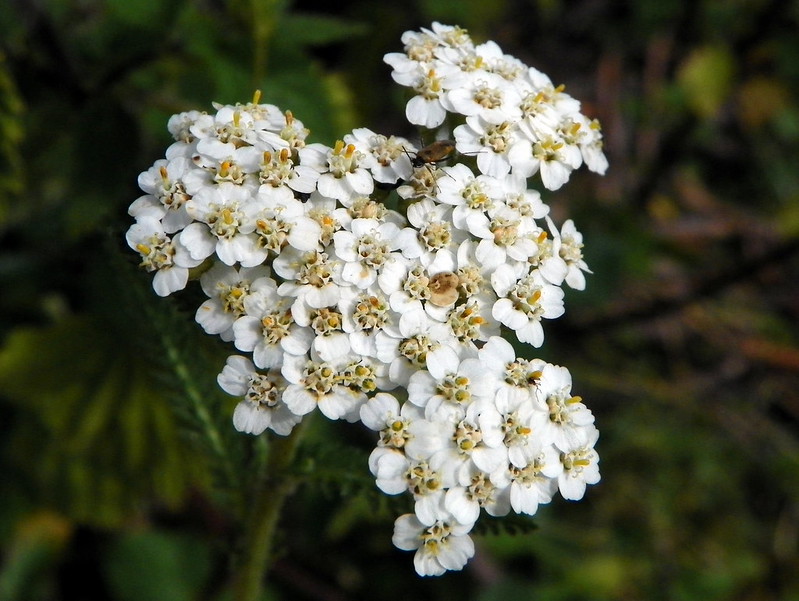
Photo Credit: Peter O’Connor / Flickr / CC BY-SA 2.0
There’s no better low-maintenance landscape plant than natives. They are hardy and grow more productively in Mississippi’s unique climate than non-natives because they are accustomed to the Magnolia State’s soil, pests, diseases, and climate.
Check out some of the best low-maintenance native plants
- Azalea (Rhododendron)
- Tickseed (Coreopsis)
- Eastern Bluestar (Amsonia tabernaemontana)
- Oakleaf Hydrangea (Hydrangea quercifolia)
- Red Buckeye (Aesculus pavia)
- Yarrow (Achillea millefolium)
Advantages of native plants:
- Thrive in Mississippi’s subtropical climate and four seasons
- Require less water, fertilizer, and pesticides
- Support a diverse ecosystem, providing food and shelter for local wildlife, hummingbirds, and pollinators
- Disease and pest-resistant
- Prevent water run-off
- Improve air quality
Estimated cost: Native plant prices vary widely based on many factors, including type, size, and location. On average, you can expect to spend between $15 to $50 per shrub, $5 to $50 per vine, and $200 to $1,500 per tree..
2. Add Hardscapes
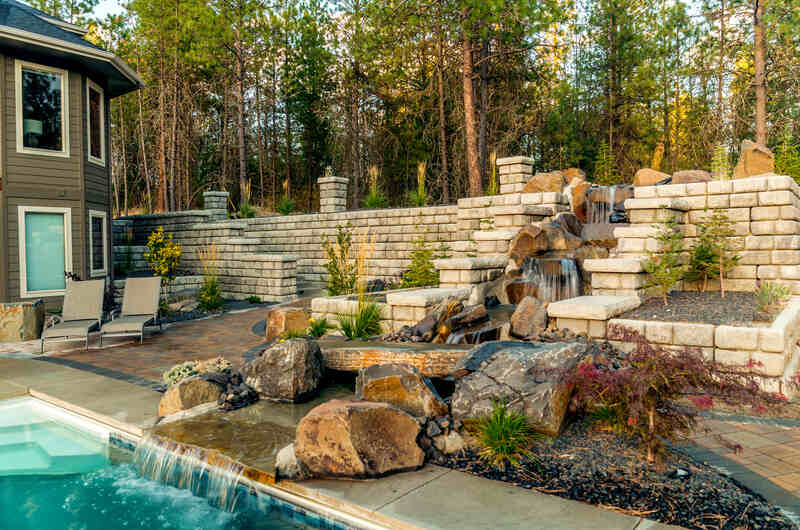
Photo Credit: Redi-Rock International / Flickr / CC BY 2.0
If your idea of low-maintenance landscaping is no-maintenance landscaping, installing hardscapes is one solution. Hardscapes are man-made features used in landscape architecture. They are a set-it-and-forget-it landscaping solution that only requires an annual cleaning.
Common hardscapes include:
- Rock gardens
- Walkways
- Patios
- Decks
- Pergolas
- Fire pits
- Outdoor kitchens
Advantages of hardscapes:
- Only require annual cleaning
- Increase property value and curb appeal
- Define spaces and increase functionality: entertaining, cooking, outdoor living
- Conserve water
- Reduce weeds and pests
- Create shade
- Reduce soil erosion
Estimated cost: Be prepared to spend around $7,500 for a new deck, $4,000 for a patio, $850 for a fire pit, and $3,000 for a flagstone walkway.
3. Conserve Water With Xeriscaping
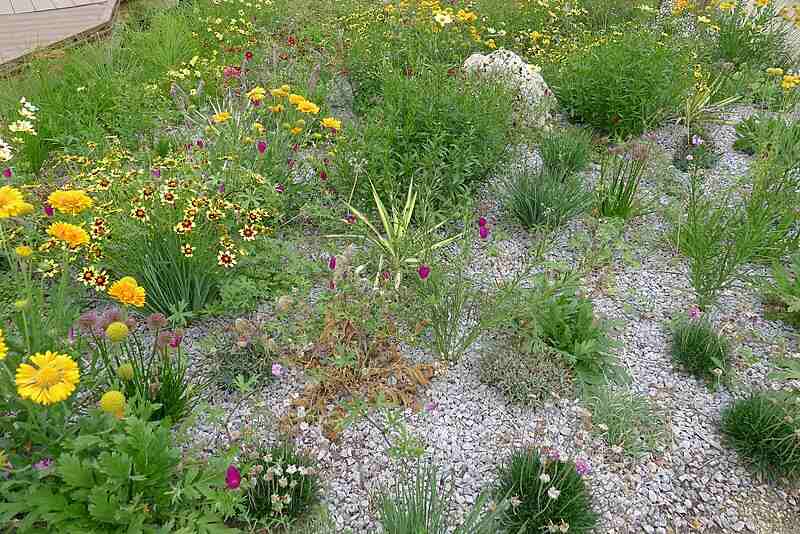
Photo Credit: James Steakley / Wikimedia Commons / CC BY-SA 4.0
Like hardscaping, xeriscaping focuses on low-maintenance landscaping with additional emphasis on water conservation. Xeriscaping involves creating a beautiful home landscape that requires no watering except natural rainfall.
- Plan and hydrozone your landscape by grouping plants with similar water needs together
- Mulch your flower beds for maximum water retention
- Install smart irrigation with a rain sensor, drip lines, and automatic sprinklers
- Minimize turfgrass area
- Blend hardscaping elements into your landscape
Advantages of xeriscaping:
- Conserves water
- Reduces pesticide and herbicide use
- Lowers water bills
- Reduces runoff
Estimated cost: Professional xeriscaping costs between $5 to $20 per square foot, depending on many factors like plant selection and the size of your yard. While upfront costs may seem high, you will save around $0.36 per square foot annually on water and maintenance costs.
4. Plant Groundcover
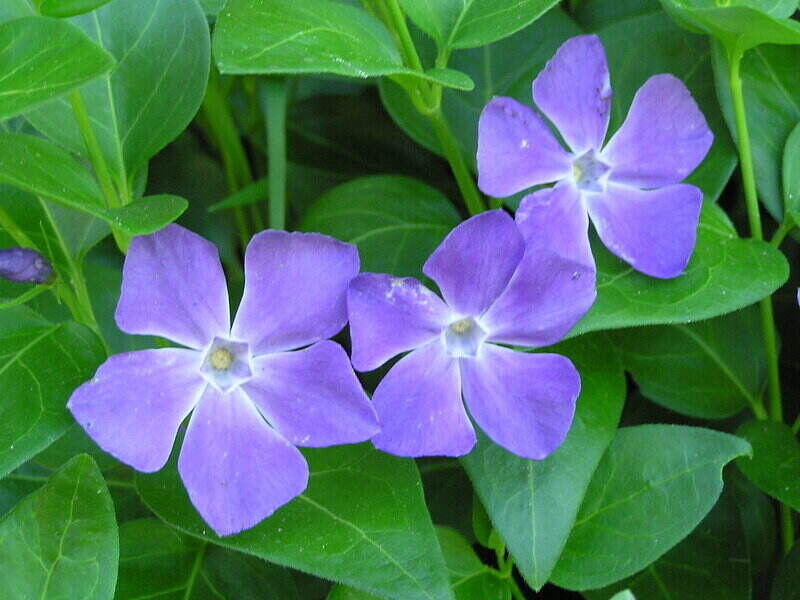
Photo Credit: Cslucas / Wikimedia Commons / CC BY-SA 4.0
Lawn maintenance isn’t for everyone, and your lawn doesn’t need to be covered in traditional grass to have a thick, green appearance. Low-maintenance groundcover makes a great alternative to grass. Groundcovers are low-lying perennial plants with a creeping, spreading habit, used to cover sections of ground with minimal maintenance and mowing.
Deeply shaded areas and steep slopes that are difficult to mow are perfect spots for growing groundcovers.
Check out some Mississippi groundcovers::
- Bigleaf Vinca (Vinca major)
- Japanese Star Jasmine (Trachelospermum asiaticum)
- Liriope (Lirope muscari)
Advantages of ground covers:
- Conserves water
- Pest resistant
- No mowing required
- Fewer weeds
- Requires fewer chemicals
Estimated cost: According to Lowes, groundcover plants cost around $5 to $50 each, depending on size.
5. Install Artificial Turf
Artificial grass hasn’t always had the best rep, but it has come a long way. Modern, high-quality artificial turf can be just as vibrant and soft as traditional turfgrass and comes in many colors and textures. Without close inspection, your neighbors won’t be able to tell the difference.
Unfortunately, artificial grass is costly and some argue that it negatively affects the environment. However, studies have shown that it doesn’t present increased risk to soils, and the environmental impact is minimal.
Advantages of artificial turf:
- No maintenance other than occasional cleaning
- Pest free
- Reduces water consumption
- Doesn’t require chemicals
- Lasts up to 20 years
Estimated cost: Professional artificial grass installation costs between $5 to $20 per square foot.
6. Mulch Your Flower Beds
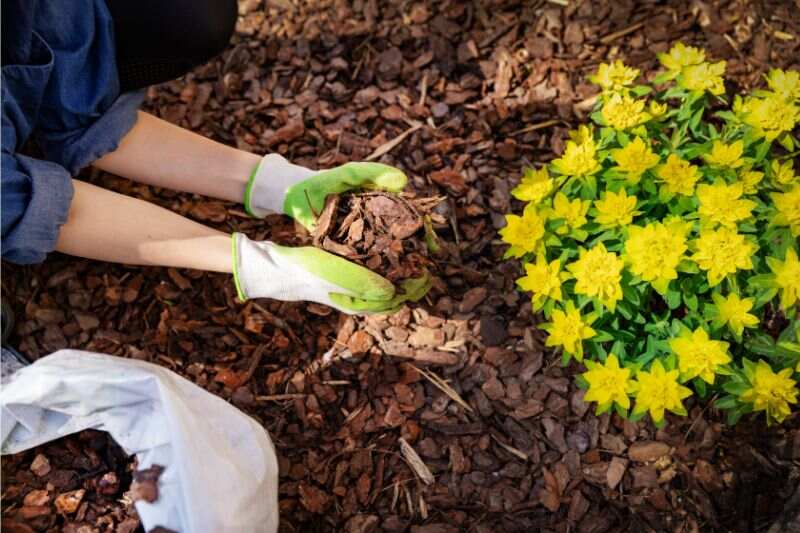
Photo Credit: ronstik / Canva Pro / License
Another inexpensive, low-maintenance option is mulch. Mulch helps reduce weeds, conserve moisture, and protect your plants’ roots from cold and heat. It is a loose material typically made of inorganic or organic matter like compost, tree bark, wood chips, or rubber.
Some examples of mulch are:
Organic mulch:
- Hardwood and softwood chips
- Bark
- Wood shavings
- Pine needles
- Straw or hay
- Leaves
- Grass clippings
Inorganic mulch:
- Rock, stone, lava rock
- Landscape glass
- Rubber mulch
- Landscape fabric
- Reflective mulch
Advantages of mulch:
- Increases moisture retention
- Reduces weeds
- Protects plant roots from extreme heat and cold
- Reduces evaporation
- Adds curb appeal
Estimated cost: According to Lowes and Home Depot, wood mulch costs between $3 to $5 per 2-cubic-foot bag. Rubber mulch is more durable and expensive, costing around $8 to $10 per 0.8-cubic-foot bag. If your landscaping project requires a lot of mulch, you can often purchase it in bulk to save money.
7. Plant Perennials
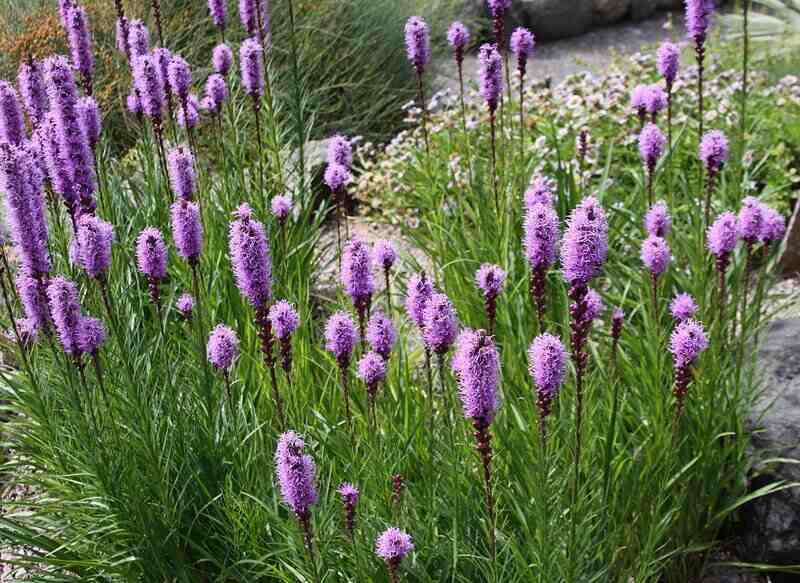
Photo Credit: Drew Avery / Wikimedia Commons / CC BY 2.0
If you are considering low-maintenance landscaping options, it is important to understand the difference between perennial and annual plants. Annuals germinate, flower, set seeds, and die, all in one season. To keep your landscape looking great, you’ll need to replant them year after year.
Unlike annuals, perennials are typically cold-hardy, going dormant in the winter and returning in the spring. They typically bloom for one season each year, though some species are long-blooming. When grown in favorable conditions, perennials can live decades.
Check out some popular Mississippi perennials:
- Asters (Aster Spp.)
- Black-Eyed Susan (Rudbeckia hirta)
- Blazing Stars (Liatris)
- Daylily (Hemerocallis)
- Lanceleaf Coreopsis (Coreopsis lanceolata)
- Oakleaf Hydrangea (Hydrangea quercifolia)
- Yarrow (Achillea)
Advantages of perennials:
- Bloom yearly
- Last 10-20 years or more
- Improve soil structure
- Prevent erosion
- Water and nutrient-efficient
Estimated cost: Like native plants, the average cost of perennial plants varies depending on the size and type of plant, purchase location, and whether you are having a professional handle your landscaping. If you head to your local store to purchase your own perennials, you can expect to spend between $10 to $100 per plant.
FAQ About Low-Maintenance Mississippi Landscaping
If you don’t want to splurge on hardscaping features, there are many inexpensive options available, including:
• Concrete pavers
• Gravel
• Mulch
• Timber edging to define flower beds
If you’re just starting out in landscaping, follow these easy steps:
• Determine your exact landscaping wants and needs. Make a list to keep everything organized.
• Think about location. Consider weather patterns throughout the year when designing your landscape.
• Spend time in your landscape. Live with it for a while before making any changes.
• Start out small. One of the most satisfying parts of landscaping is slowly developing a plan and enjoying the process.
• Find a focal point. Use a sculpture, beautiful tree, or shrubs.
• Focus on scale and design. To give your yard a pulled-together appearance, mix and match various features in your landscape. Vary size, shape, and color to create contrast and visual interest.
• Be open to change. Be honest about what’s working for you and what’s not. Tastes change. Don’t be afraid to experiment.
Gravel is an inexpensive hardscaping option with many benefits.
• Cost-effective: Gravel is less expensive than other options like natural stone or concrete.
• Versatile: Use gravel to create pathways, driveways, and to line flower beds or drainage areas. It is available in many colors, textures, and sizes.
• Low-maintenance: Gravel blocks weeds and doesn’t require mowing, watering, fertilizing, or chemical sprays.
• Good drainage: Gravel promotes drainage, allowing water to pass through easily.
Professional Help for Your Low-Maintenance Mississippi Landscape
We all want a beautiful yard, but some of us don’t want to spend hours outside mowing, fertilizing, watering, and weeding. Your low-maintenance additions will come together with your native plants and turfgrass to create your complete landscape.
If you need help deciding where to begin, let Wikilawn connect you with a local lawn care pro in your area that will take care of the heavy lifting. Our trusted experts are spread out across Jackson, Southaven, Olive Branch, Pearl, Ridgeland, and many other cities in the Magnolia State.
Main Image Credit: Natchez, Mississippi / Rsfinalayson / Wikimedia Commons / CC BY-SA 4.0